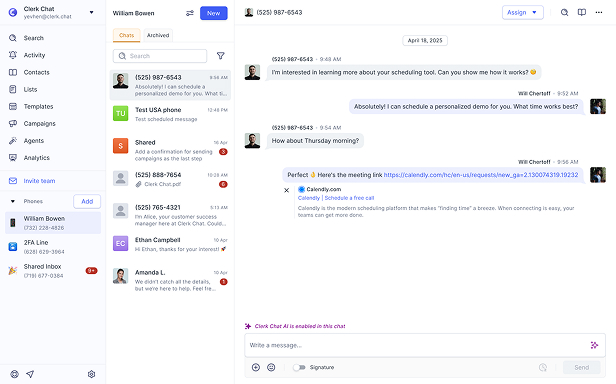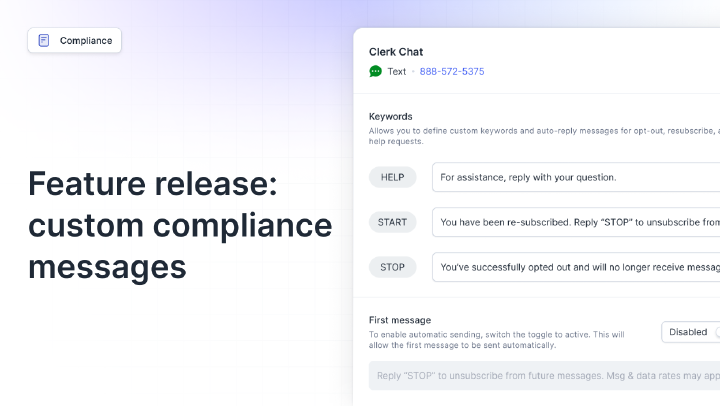Two-Way Messaging
[tu weɪ ˈmɛsɪdʒɪŋ]Two-way messaging is the ability for businesses to send SMS messages and receive replies, enabling real-time, conversational communication with customers. It supports automation, personalization, and escalation - creating a more engaging and responsive experience.
Why two-way messaging matters
One-sided communication has limits - especially in customer service, sales, and operations. Two-way messaging opens up a true dialogue, allowing customers to respond, ask questions, confirm details, or request help in real time. This immediacy leads to faster resolution, better engagement, and higher satisfaction.
Businesses benefit from higher response rates and more context-rich interactions. For example, a customer can reply to an appointment reminder to confirm or reschedule. A sales lead can ask a question about pricing and get an instant answer. With tools like Clerk Chat, two-way messaging becomes even more powerful with built-in routing, AI, and CRM integrations.
Whether you’re answering inquiries or following up with prospects, two-way SMS makes your outreach human, timely, and effective.
How two-way messaging works
Here’s how two-way messaging functions in a typical setup:
- Enable a textable number – This can be a long code, toll-free number, or VoIP-enabled line.
- Integrate with a platform – Use Clerk Chat or another messaging system that supports real-time responses and routing.
- Send initial messages – These could be automated texts, campaigns, reminders, or direct replies to inbound messages.
- Receive and interpret replies – Messages come into a shared inbox or team workspace (like Slack or Teams).
- Respond manually or with AI – Human agents can reply, or AI can suggest/send responses automatically.
- Trigger workflows – Based on the reply, you can update a CRM, send follow-ups, or escalate to another team.
With Clerk Chat, everything from auto-responses to message tags and routing rules is built in - making two-way messaging scalable and seamless.
Best practices with two-way messaging
Use conversational language - SMS is a personal channel. Keep tone friendly and natural.
Respond promptly - Set SLAs or use automation to ensure customers aren’t left waiting.
Log every conversation - Sync replies with your CRM for full customer history and follow-up context.
Automate simple replies - Let AI handle common questions to reduce manual work.
Set expectations early - Let users know when you’re available to reply or how to get urgent help.
Respect opt-outs - Every two-way thread should make it easy for users to stop messages at any time.
Route conversations smartly - Use keywords or AI to assign replies to the right team or department.
Real world examples
- Customer service
Cut resolution time by 32% using two-way messaging for inbound support tickets.
Read more - Logistics
Used SMS replies to confirm deliveries - reducing missed drop-offs by 40%.
Read more
Common misconceptions
It also includes tracking, automation, and workflows that trigger based on customer responses.
Sales, marketing, logistics, and operations teams also use it to engage leads, confirm deliveries, and more.
Platforms like Clerk Chat make it easy to activate with no complex setup or custom code.
Modern systems combine automation and AI to handle replies instantly, with smart escalation if needed.
Related terms
In this article:
Ready to use your business number for text messaging?
Thousands of businesses are already experiencing the power of conversational messaging through SMS. Join us. Free trial and paid tiers available.
Get StartedFAQ
Have questions? We've got answers.
Find what you need quickly and clearly with our most frequently asked questions.
Two-way messaging allows businesses to send messages and receive replies via SMS. It enables real-time conversations with customers and supports automation, routing, and personalization based on each message.
Yes. Clerk Chat supports true two-way messaging with your existing number or a new one. You can manage replies directly in Slack, Microsoft Teams, or the web app, and automate responses with AI if needed.
Yes. Both long codes and toll-free numbers support two-way messaging. Just make sure the number is properly registered for A2P use and integrated with your messaging platform.
It’s commonly used for appointment confirmations, customer support, follow-ups, product questions, delivery coordination, and lead engagement. Any situation where response matters benefits from two-way SMS.
No. Platforms like Clerk Chat allow you to automate common replies and use AI agents to triage conversations - human agents only step in when needed.
Yes, as long as customers opt in and can easily opt out. All replies must respect user consent. Clerk Chat automates compliance features like opt-out handling and consent tracking.




